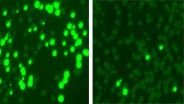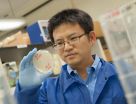Discovery of a novel heart and gut disease
The genetic mutation involved would date back to 12th century Vikings
2014-10-05
(Press-News.org) This news release is available in French and German.
Physicians and researchers at CHU Sainte-Justine, Université de Montréal, CHU de Québec, Université Laval, and Hubrecht Institute have discovered a rare disease affecting both heart rate and intestinal movements. The disease, which has been named "Chronic Atrial Intestinal Dysrhythmia syndrome" (CAID), is a serious condition caused by a rare genetic mutation. This finding demonstrates that heart and guts rhythmic contractions are closely linked by a single gene in the human body, as shown in a study published on October 5, 2014 in Nature Genetics.
The research teams in Canada have also developed a diagnostic test for the CAID syndrome. "This test will identify with certainty the syndrome, which is characterized by the combined presence of various cardiac and intestinal symptoms," said Dr. Gregor Andelfinger, a pediatric cardiologist and researcher at CHU Sainte-Justine "The symptoms are severe, and treatments are very aggressive and invasive, added Dr. Philippe Chetaille, a pediatric cardiologist and researcher at the university hospital CHU de Québec." At cardiac level, patients suffer primarily from a slow heart rate, a condition which will require the implantation of a pacemaker for half of them, often as early as in their childhood. At digestive level, a chronic intestinal pseudo-obstruction will often force patients to feed exclusively intravenously. Furthermore, many of them will also have to undergo bowel surgery.
Discovery of the CAID Syndrome
By analysing the DNA of patients of French-Canadian origin and a patient of Scandinavian origin showing both the cardiac and the gastrointestinal condition, the researchers were able to identify a mutation in the gene SGOL1 that is common to all of patients showing both profiles. "To lift any doubts concerning the role of the identified mutation, we also made sure it was ruled out in people showing only one of the profiles," said Dr. Andelfinger. Similarly, Dr. Jeroen Bakkers, at Hubrecht Institute, in The Netherlands, who also collaborated to the project, studied zebrafish with the same gene mutation "The mutated fish showed the same cardiac symptoms as humans, which confirms the causal role played by SGOL1", he continued.
A Transatlantic Founder effect
The research team traced back the genealogy of eight patients of French-Canadian origin using the Quebec population BALSAC historical data base. They were able to identify a common ancestry dating back to the 17th century, more precisely a founder couple married in France in 1620. Molecular genetic tests also proved that the identified French-Canadian and the Swedish mutations share the same origin, suggesting the existence of a founder effect and the major role played by migration of populations. According to the investigators' calculations, the genetic legacy would date back to the 12th century, then following the migration route of the Vikings from Scandinavia to Normandy, then that of the settlers who migrated to New France in the 17th century.
An Unsuspected Role for SGOL1
The researchers believe that the mutation of SGOL1 acts mechanistically to reduce the protection of specific nerve and muscle cells in the gut and the heart, causing them to age prematurely due to an accelerated replication cycle. Their findings suggest an unsuspected role for SGOL1 in the heart's ability to maintain its rhythm throughout life.
The specific role played by the gene and the impact of its mutation will take center stage in future investigations of the research group. Along with physicians and patients, the group hopes their understanding of the disease will help them identify new avenues for treatments specifically targeting the underlying genetic and molecular causes.
INFORMATION:
About the Study
The study "Mutations in a novel because SGOL1 cohesinopathy affecting heart and gut rhythm" was published in Nature Genetics on October 5, 2014. Funding for this project provided by the FORGE Canada Consortium, the Canadian Institutes of Health Research, the Ontario Genomics Institute, Genome Quebec, Genome British Columbia, and André Foundation Nussia Aisenstadt, GO Foundation, Leducq Foundation and Association des pseudo-obstructions intestinales chroniques, France.
About the Researchers
Dr. Gregor Andelfinger, MD is a pediatric cardiologist at CHU Sainte-Justine, a researcher at Sainte-Justine University Hospital Research Center in the Fetomaternal and Neonatal Pathologies axis, and Associate Research Professor in the Department of Pediatrics at Université de Montréal. He also holds a Research Chair in cardiovascular genetics.
Dr. Philippe Chetaille, MD, MSc, is a pediatric cardiologist at CHU de Québec, an Associate Researcher at CHU de Québec Research Centre and a Full Associate Professor in the Department of Pediatrics at the Université Laval
Dr. Jeroen Bakkers, PhD, is a senior principle investigator of the Cardiac Development and Genetics group at the Hubrecht Institute in Utrecht, the Netherlands.
Interviews and Filming Opportunities
Researchers, physicians, patients and parents are available for interviews on request.
ELSE PRESS RELEASES FROM THIS DATE:
2014-10-05
A new crystallographic technique developed at the University of Leeds is set to transform scientists' ability to observe how molecules work.
A research paper, published in the journal Nature Methods on October 5, describes a new way of doing time-resolved crystallography, a method that researchers use to observe changes within the structure of molecules.
Although fast time-resolved crystallography (Laue crystallography) has previously been possible, it has required advanced instrumentation that is only available at three sites worldwide. Only a handful of proteins ...
2014-10-05
A study published in Nature Geoscience shows that air pollution has had a significant impact on the amount of water flowing through many rivers in the northern hemisphere.
The paper shows how such pollution, known as aerosols, can have an impact on the natural environment and highlights the importance of considering these factors in assessments of future climate change.
The research resulted from a collaboration between scientists at the Met Office, Centre for Ecology and Hydrology, University of Reading, Laboratoire de Météorologie Dynamique in France, and the University ...
2014-10-05
The multitude of microbes scientists have found populating the human body have good, bad and mostly mysterious implications for our health. But when something goes wrong, we defend ourselves with the undiscriminating brute force of traditional antibiotics, which wipe out everything at once, regardless of the consequences.
Researchers at Rockefeller University and their collaborators are working on a smarter antibiotic. And in research to be published October 5 in Nature Biotechnology, the team describes a 'programmable' antibiotic technique that selectively targets the ...
2014-10-05
Type 2 diabetes affects an estimated 28 million Americans according to the American Diabetes Association, but medications now available only treat symptoms, not the root cause of the disease. New research from Rutgers shows promising evidence that a modified form of a different drug, niclosamide – now used to eliminate intestinal parasites – may hold the key to battling the disease at its source.
The study, led by Victor Shengkan Jin, an associate professor of pharmacology at Rutgers Robert Wood Johnson Medical School, has been published online by the journal Nature ...
2014-10-03
Montréal, October 2, 2014 – Scientists at the IRCM discovered a mechanism that promotes the progression of medulloblastoma, the most common brain tumour found in children. The team, led by Frédéric Charron, PhD, found that a protein known as Sonic Hedgehog induces DNA damage, which causes the cancer to develop. This important breakthrough will be published in the October 13 issue of the prestigious scientific journal Developmental Cell. The editors also selected the article to be featured on the journal's cover.
Sonic Hedgehog belongs to a family of proteins that gives ...
2014-10-03
Despite the legalization of same-sex marriage in 19 states and the District of Columbia and an executive order to prohibit federal contractors from discrimination against lesbian, gay, bisexual, and transgender employees, LGBT individuals face tremendous hurdles in access to health care and basic human rights. A special report published by The Hastings Center, LGBT Bioethics: Visibility, Disparities, and Dialogue, is a call to action for the bioethics field to help right the wrongs in the ways that law, medicine, and society have treated LGBT people.
The editors are Tia ...
2014-10-03
FALLS CHURCH, Va. (October 3, 2014) — A new National Institute for Occupational Safety and Health (NIOSH) study, published online in the Journal of Occupational and Environmental Hygiene, found that recommended safe handling practices for workers who administer antineoplastic drugs in healthcare settings are not always followed.
Results are derived from the 2011 Health and Safety Practices Survey of Healthcare Workers, the largest federally-sponsored survey of healthcare workers in the U.S., which addresses safety and health practices relative to use of hazardous chemicals. ...
2014-10-03
Men who consume more alcohol have a greater risk of human papillomavirus (HPV) infection, according to a recent study by Moffitt Cancer Center researchers.
HPV is a common sexually transmitted virus, with more than six million new infections in the United States each year. HPV causes genital warts in both men and women and is a contributing factor to a number of different cancers in women, including cervical, vaginal and anal cancers. More recent studies have shown that HPV can also cause penile, anal and oropharyngeal cancer in men. However, there is limited data regarding ...
2014-10-03
A snaking, extended filament of solar material currently lies on the front of the sun-- some 1 million miles across from end to end. Filaments are clouds of solar material suspended above the sun by powerful magnetic forces. Though notoriously unstable, filaments can last for days or even weeks.
NASA's Solar Dynamics Observatory, or SDO, which watches the sun 24 hours a day, has observed this gigantic filament for several days as it rotated around with the sun. If straightened out, the filament would reach almost across the whole sun, about 1 million miles or 100 times ...
2014-10-03
In response to the rise of drug-resistant pathogens, doctors are routinely cautioned against overprescribing antimicrobials. But when a patient has a confirmed bacterial infection, the advice is to treat aggressively to quash the infection before the bacteria can develop resistance.
A new study questions the accepted wisdom that aggressive treatment with high drug dosages and long durations is always the best way to stem the emergence and spread of resistant pathogens. The review of nearly 70 studies of antimicrobial resistance, which was authored by researchers at Princeton ...
LAST 30 PRESS RELEASES:
[Press-News.org] Discovery of a novel heart and gut disease
The genetic mutation involved would date back to 12th century Vikings


